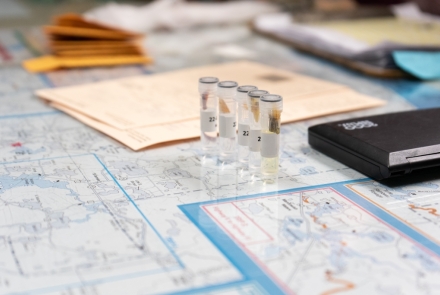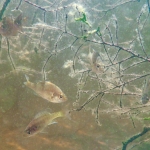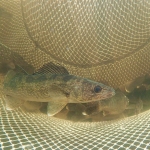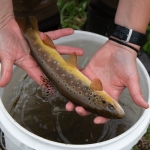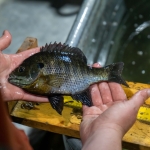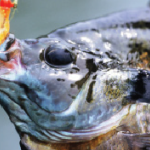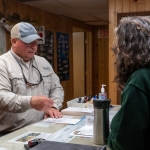Fisheries Research
Our team of fisheries research scientists, biologists and technicians produce objective, applicable science for the DNR that helps inform fisheries management decisions. Staff are engaged in high-priority research projects related to Wisconsin sport fishes, with specialties including applied fisheries management and ecology, quantitative stock assessments, fish habitat, propagation science and population dynamics.
The fisheries research team works together to cover the diversity of Wisconsin's aquatic habitats and species with three stations across the state: Escanaba Lake Research Station in the Northern Highland Fishery Research Area (NHFRA), the Science Operations Center in Madison, and the DNR Service Center and Tommy G. Thompson State Hatchery in Spooner. The team collaborates with anglers, universities, state hatcheries, tribal partners and conservation groups across the state and country to help meet fisheries research needs.
Northern Highland Fishery Research Area Studies
The Northern Highland Fishery Research Area (NHFRA) provides a suite of experimental lakes in the Boulder Junction area for the long-term purposes of monitoring angler behaviors, fish population dynamics, and ecosystem-scale studies to benefit fisheries across Wisconsin. Numerous studies have been conducted in the NHFRA over its long history, including fisheries regulations, effects of angler habits on fish populations, fish biology and fish species interactions. In addition to the regular compulsory creel, seasonal field surveys and ongoing monitoring efforts, NHFRA staff are currently conducting the following research projects:
Fish Production with Coarse Woody Habitat Additions
Goal: Measure the effects of adding coarse woody habitat on the fish-carrying capacity of Wisconsin lakes.
Fish Community Production Distribution in Walleye Lakes
Goal: Determine how fish production is being (re)distributed in declining walleye lakes compared to walleye lakes that have remained stable in recent years.
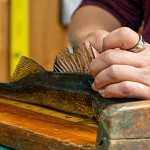
Water Level Fluctuation Impacts on Walleye Spawning Habitat
Goal: Evaluate whether fluctuations in annual water levels influence walleye spawning habitat and reproductive success in northern Wisconsin lakes.
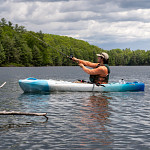
The Effects of Forward-Facing Sonar on Recreational Fisheries
Goal: Using multiple approaches, understand the effects of forward-facing sonar on angler catch rates and behavior.
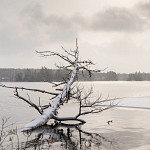
Dictating Lake Ice Phenology and Summer Water Temperatures
Goal: Simulate climate change influences on lake ice to better understand the responses of fish populations and the aquatic ecosystem of Escanaba Lake.
Evaluating the Relationship Between Population Productivity and Depensation in Wisconsin Walleye
Goal: Use long-term data to explore mechanisms leading to depensatory recruitment in walleye.
Statewide Fisheries Research Studies
Fisheries scientists in the Office of Applied Science also work together on projects across the state, from the cold waters of Lake Superior to the streams and lakes of southern Wisconsin. Staff work with collaborators and stakeholders to better understand and meet research needs and are currently working on the following projects:
Muskellunge Age and Growth Study
Goal: Evaluate non-destructive means for determining muskellunge age and growth, as well as determine the effects of catch-and-release on muskellunge mortality and size structure.
Spawning Dynamics of Northern Pike and Muskellunge
Goal: Investigate northern pike and muskellunge interactions and competition, with a focus on spawning behavior.
Spawning Phenology
Goal: Test for phenological shifts in the spawning of sport fishes around Wisconsin, understand what may be driving these shifts and determine their implications for recruitment.
Temporal Trends in Trout Populations
Goal: Measure environmental conditions over time to help understand how and why trout populations vary in response to water temperature, stream flow and other habitat variables.
Reassessing the Predator-Prey Balance on Lake Michigan
Goal: Reassess the predator-prey balance in Lake Michigan to account for recent changes in the prey fish community and associated shifts in feeding dynamics.
Assessing Effects of Alum Treatments on Panfish Growth and Recruitment
Goal: Evaluate the influences of aluminum sulfate treatments for Big Round Lake on panfish size, growth and abundance.
Panfish Responses to Angling and Predation
Goal: Assess trends in Wisconsin's panfish populations (abundance and size structure) in response to angler exploitation and predator management.
Evaluating Creel Survey Efficiencies for Wisconsin's Recreational Fisheries
Goal: Improve creel survey efforts by combining a model-based approach and reallocation of sampling efforts across space and time.
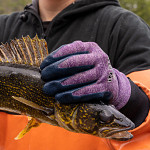
Integrating Structured Decision Making and Resist-Accept-Direct for Walleye Management in Wisconsin
Goal: Develop a transparent, reproducible decision-making tool that will help walleye population managers use their resources as efficiently as possible.
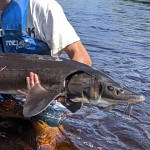
Assessing Lake Sturgeon Escapement in Wisconsin and Chippewa River Impoundments
Goal: Assess escapement rates and patterns for recovering populations of lake sturgeon in the Wisconsin and Chippewa rivers.
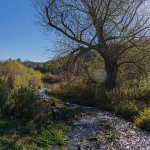
Contribution of Small and Large Fingerling Trout Stocked in Class 2 Trout Streams
Goal: Determine the importance of stocking to support trout fisheries in Class 2 trout streams across Wisconsin.
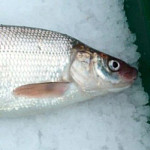
Recruitment Dynamics in North-Moonlight Bays and Green Bay Lake Whitefish Spawning Populations
Goal: Inform harvest rules and promote the development of strategies to ensure the long-term sustainability of lake whitefish fisheries in Wisconsin.
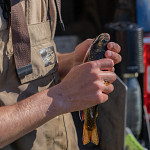
The Effects of Neonicotinoids on Stream Macroinvertebrates and Trout
Goal: Quantify the levels of commonly used neonicotinoids in trout streams and their potential effect on macroinvertebrate assemblages and the trout populations they support.
Scientific Consulting
In addition to the research projects above, the Office of Applied Science also provides consultation services to the Division of Fish, Wildlife and Parks. These consultation services are often in the form of population analyses, scientific design or analysis services and consultation on management issues to ensure the best possible scientific information is available to decision-makers.
The open dialogue between the Office of Applied Science and the Bureaus of Wildlife Management and Fisheries Management helps drive our research foci so that research directly fills the research needs of decision-makers.
Publications and reports
View a list and links to our recent journal publications and reports. For NHFRA-specific peer-reviewed papers, please see NHFRA Publications.

